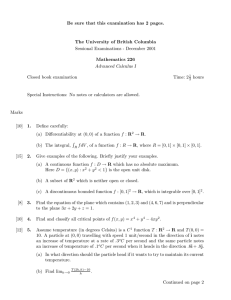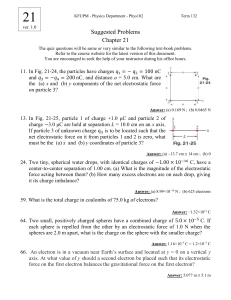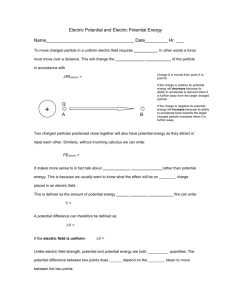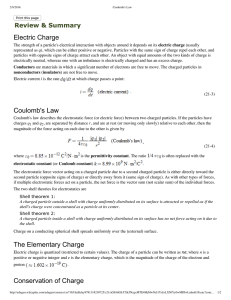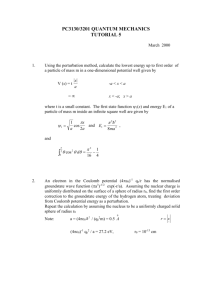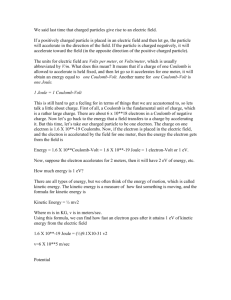T2s12 9AM
advertisement
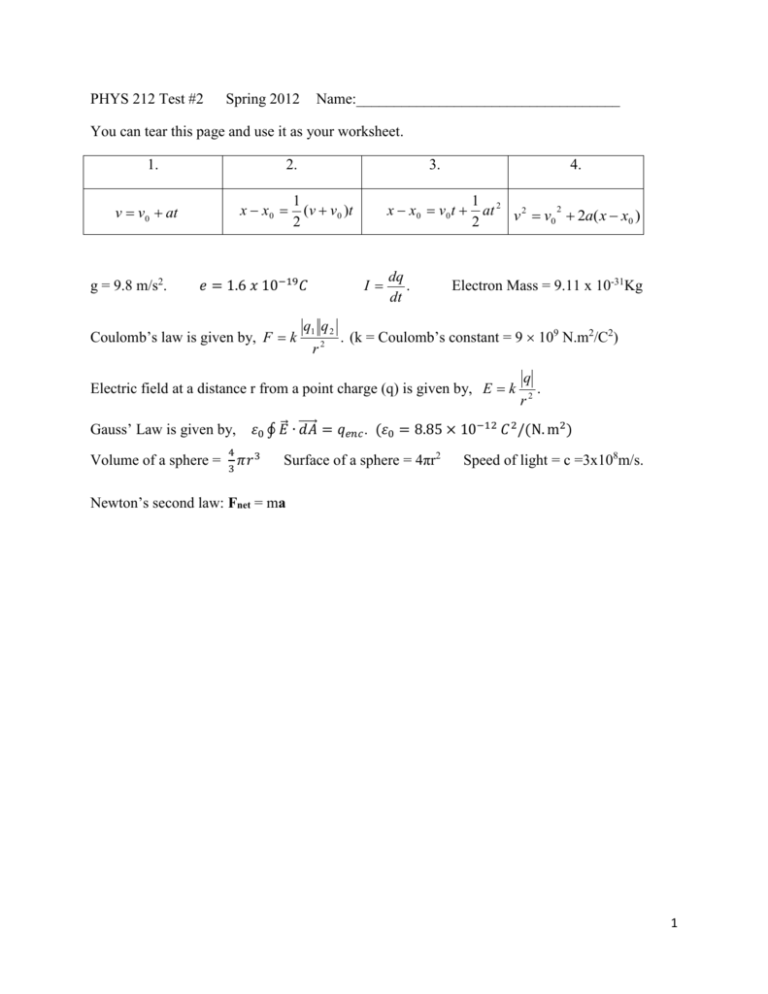
PHYS 212 Test #2 Spring 2012 Name:___________________________________ You can tear this page and use it as your worksheet. 1. 2. x x0 v v0 at g = 9.8 m/s2. 3. 1 (v v 0 )t 2 Coulomb’s law is given by, F k x x0 v0 t I 𝑒 = 1.6 𝑥 10−19 𝐶 q1 q 2 r2 4. dq . dt 1 2 at v 2 v 2 2a( x x ) 0 0 2 Electron Mass = 9.11 x 10-31Kg . (k = Coulomb’s constant = 9 109 N.m2/C2) Electric field at a distance r from a point charge (q) is given by, E k Gauss’ Law is given by, Volume of a sphere = 4 3 q r2 . 𝜀0 ∮ 𝐸⃗ ∙ ⃗⃗⃗⃗⃗ 𝑑𝐴 = 𝑞𝑒𝑛𝑐 . (𝜀0 = 8.85 × 10−12 𝐶 2 /(N. m2 ) 𝜋𝑟 3 Surface of a sphere = 4πr2 Speed of light = c =3x108m/s. Newton’s second law: Fnet = ma 1 PHYS 212 Spring 2011 Test #2 Name:_____________________________ 1. In the figure below, a central particle of charge –2q is surrounded by a square array (side = a) of charged particles, along the perimeter of the square. What is the magnitude of the net electrostatic force on the central particle due to the other particles? (Express your answer in terms of k, q, and a. 2. Deals with the electric field lines of two charges as shown: a. What are the polarities of the charges:______________ b. The ratio of the charges C/D is: ___________ 3. In crystals of the salt cesium chloride, cesium ions Cs+ form the eight corners of a cube and a chlorine ion Cl- is at the cube's center. The edge length of the cube is 0.40 nm. What is the length of the diagonal AB? 2 4. The axial electric field of a uniformly charged ring is given by: a. What is E as z goes to zero?_______________ b. What is E as R goes to zero?_______________ 5. Figure above shows two concentric rings, of radii RS and RL, that lie on the same plane. Point P lies on the central z axis, at distance D from the center of the rings. The smaller ring has uniformly distributed charge QS. What is the uniformly distributed charge on the larger ring if the net electric field at P is zero? State your answer in terms of the given variables. 3 6. In the Figure below, particle 1 of charge +5e is above a floor by distance d1 = 2.20 mm and particle 2 of charge +8e is on the floor, at distance d2 = 8.60 mm horizontally from particle 1. What is the x component of the electrostatic force on particle 2 due to particle 1? 7. (a) What is the magnitude of an electron's acceleration in a uniform electric field of magnitude 1.76 × 106 N/C? (b) How long (in ns) would the electron take, starting from rest, to attain 1/19-th the speed of light? (c) How far (in mm) would it travel in that time? 4 8. Electric field due to a large uniformly charged (surface charge density = σ) non-conducting ⃗ = sheet is given by, 𝐸 𝜎 2𝜀0 . Sketch the Gaussian surface that can be used to derive the above expression in the diagram below. 9. In part (a) of Fig. 23-44 an electron is shot directly away from a uniformly charged plastic sheet, at speed vs = 3.40 × 105 m/s. The sheet is nonconducting, flat, and very large. Part (b) of the figure gives the electron's vertical velocity component v versus time t until the return to the launch point. What is the sheet's surface charge density? 5
